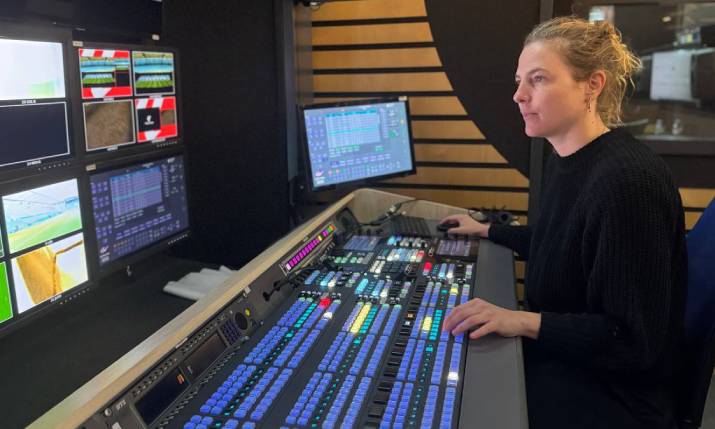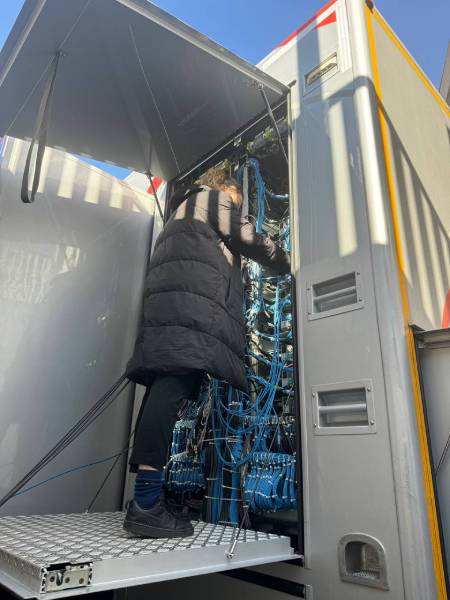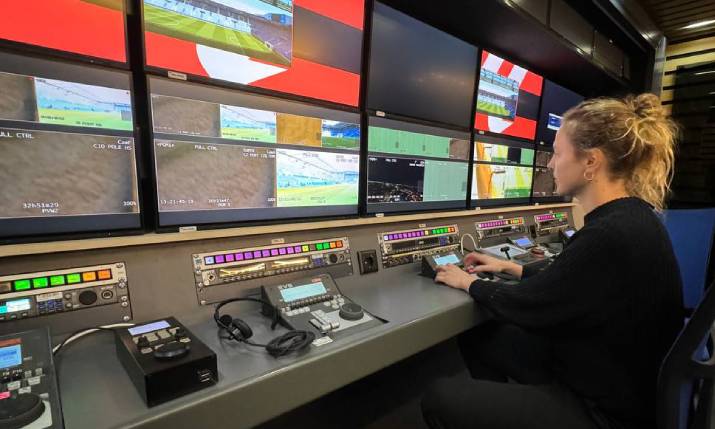Forefront of AV: Bringing live sport to global screens with Mediapro UHD HDR OB technical manager Carmen Hernandez

Carmen Hernandez, Mediapro UHD HDR OB technical manager, in the OB working on a Alavés versus FC Barcelona match on 3 February 2024
Carmen Hernandez is a UHD HDR OB technical manager for Mediapro. Based in Spain, she works across LaLiga, UEFA sports competitions, Euroleague basketball and a range of entertainment programmes. Here she gives an insight into her career, the challenges she faces, and what she thinks is the coolest part of working in sports broadcasting.
What draws you to your career in live sport?
What attracts me most about my career is being in contact with new technologies; sporting events are at the forefront of audiovisual broadcasting. I like to discover and participate in all kinds of events to cover the widest possible variety of productions.
What do you enjoy about your role?
What I like most about my job is that it’s not routine and there are always new things to learn. By working with one of the most cutting edge units of Mediapro, I have the opportunity to keep up to date with the constant evolution of audiovisual technologies.
Personally, I like to be in continuous contact with technology and enjoy configuring and studying all the possibilities of an OB. I also appreciate the satisfaction I get when, after months of planning, effort and overcoming challenges, the event gets underway, and everything works perfectly.
What advice would you give to other women looking to move into a role in sports broadcasting like your own?
Don’t hesitate! Even though it is a world that was once almost exclusively for men, there are always opportunities. Don’t be discouraged if everything doesn’t go to plan early on. Stay focused on the professional aspects, work hard and persevere.
What was hard about getting your job and learning the role?
I have had to learn and take in innumerable concepts, both in the technical area as well as in ways of working, they vary depending on the client and the event. You have to be disciplined, well organised and cool-headed to face the issues that might crop up, and try not to get lost in the details.

Mediapro’s Carmen Hernandez making the magic happen on the UHD HDR OB truck for the Alavés versus FC Barcelona game
What’s the hardest thing about it?
One of the most complicated things is to agree on what the client wants and then know how to deliver that. We work with long term clients, such as LaLiga, with whom we already have a structured workflow, and everyone is clear about what the job entails. When we embark on a project with a new client or event, one of the most important challenges is to be clear and structured about all their requirements.
Leaving aside the technical aspect, sometimes it can be complicated to balance personal and professional life, although I am used to it. In this job, most of the competitions take place on weekends, the days are long, and sometimes requiring you to travel to other cities. Planning is unpredictable, as every week is different.
How did you first find out about TV broadcasting as a career? What was your inspiration or idea, and why sports broadcasting?
I’ve always been fascinated by technology and the world of audiovisuals. When I was a child I played all sorts of sport, I liked competitions, and I followed teams whenever I had the opportunity. When I started working in the audiovisual world, I loved seeing that sports competitions are at the highest level of broadcasting, and I decided that was where I wanted to work.
What has been your career path within TV?
I started studying telecommunications engineering in college, majoring in audio and video. I was always attracted to technology and ended up deviating somewhat from the artistic vein that, in the beginning, also appealed to me.
I wanted to start working as soon as possible, so I put aside my degree and did a foundation degree in Audiovisual Production and Events. In the second year I started working as an intern in companies and that connected me directly with the audiovisual world of work. I’m currently studying the degree that I put on hold years ago.
After three months of internship, my first job in the field of broadcasting was as a satellite operator, in a DSNG, where we worked with live broadcasts for news, sports programmes, basketball games, soccer, etc. It consisted of transmitting an already prepared signal by satellite, or a unilateral signal from a camera with a microphone.
What other jobs and events have you worked on that moved you along into sports broadcasting?
In the first eight years of my working career, I worked as a satellite operator and as a camera operator. I was a freelancer and hired in Spain, especially for news. Later, in France, I covered handball for Canal+, UEFA draws and Champions League customisations. Later, based in London, I also handled satellite broadcasts, football matches for BT Sport and Champions League customisations.
Once I came back to Spain, I started working for Eumovil (Grup Mediapro) on a European Football Championship as a freelancer. As a result of that experience, I was hired as a technical director. I started working on small outside broadcast units, and little by little, I’ve been evolving, and I now work on the largest UHD OB that we have at Mediapro, and this position means I am in charge of the Spanish soccer LaLiga, UEFA sports competitions, Euroleague basketball and a range of entertainment programmes.

At the Alavés versus FC Barcelona match on 3 February, Carmen Hernandez, Mediapro UHD HDR OB technical manager
What challenges have you faced over the course of your career and how did you get you get past them?
Sometimes I have felt that I had to prove more than my [male] coworkers and that I have been trusted less because I am a woman. On one occasion, the only two self-employed women working on a project were paid less than our male counterparts doing the same job! When we discussed it, the company equalized our salary, but I don’t think that wake up call should have been necessary.
On occasion, my work has been called into questioned by people outside my team. These difficulties have given me the impetus to always give my best and to be consistent. I believe that focusing on the positive is the best way forward.
Although in this field teams are usually comprised and led by men, it is increasingly common to see women at the helm.
What’s the most challenging thing about working in live sport today, or generally, and why?
Live sports broadcasts are becoming ever more demanding, with more and more cameras and graphic elements, recordings, etc. Sport itself is more dynamic than other audiovisual events, and that requires seamless coordination throughout.
The technologies used in sports broadcasting have evolved rapidly over recent years. What for you in your day-to-day job is the most exciting, and also what is the biggest gamechanger for this industry overall?
One of the most outstanding innovations In recent years is the capacity to remotely deliver specific tasks, with the technical and editing directors being the only ones who actually need to travel. This has changed the way we work but there is still a long way to go in this regard.
What do you think has been a particularly exciting or cutting edge thing in sports broadcasting that your company has done?
The cameras we use at Mediapro are becoming more and more sophisticated. Virtual graphics and embeddings are becoming more and more complex, year on year. There is a constant evolution of audiovisual technology. An evolution that a few years ago was marked by 4K HDR broadcasts and now IP video, which is already beginning to be implemented in the most cutting edge events we work on in the group.
What’s the coolest thing you’ve worked on in the course of your career? Why?
I enjoyed covering the motorcycle world championship and traveling all around the world. Lately, one of the productions I have enjoyed the most is the America’s Cup sailing preliminaries. It required a huge effort from the entire team and the result is…well, outstanding.

